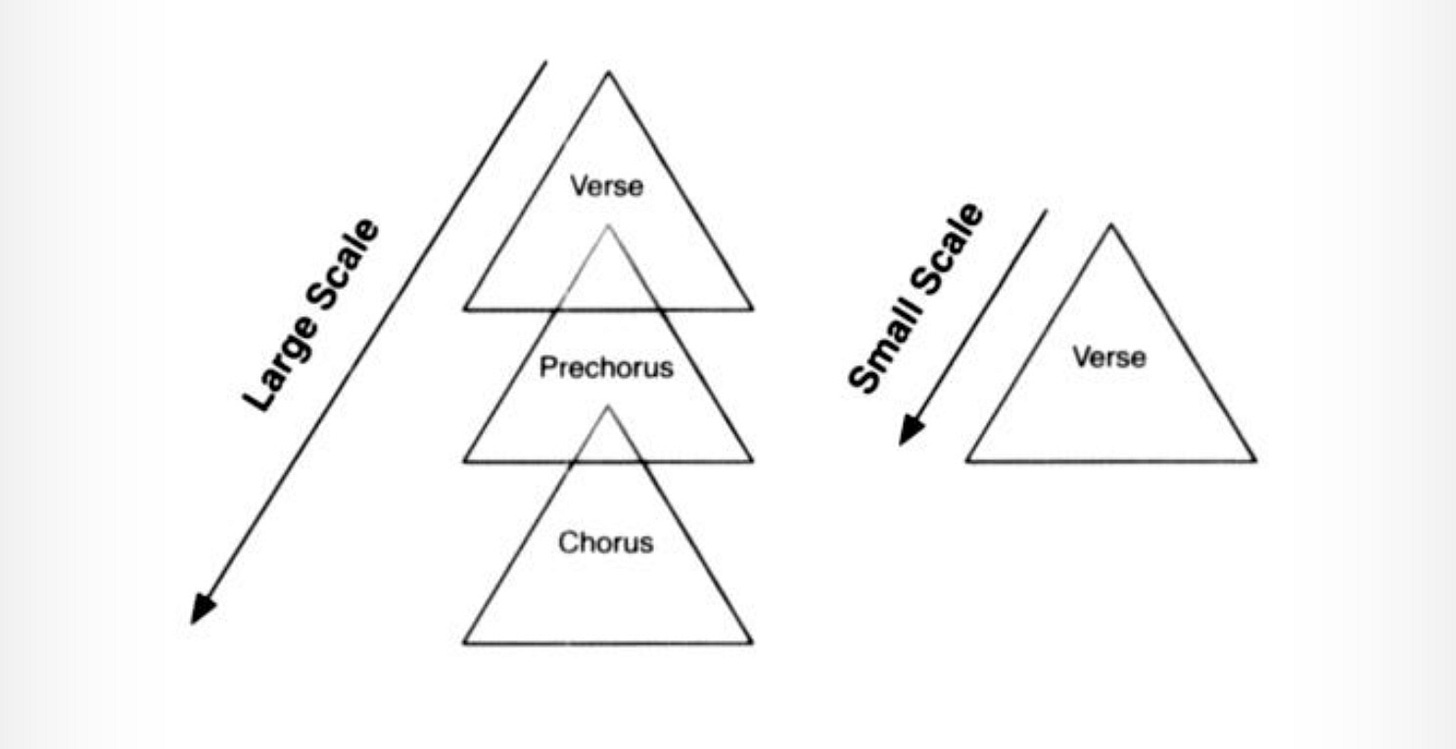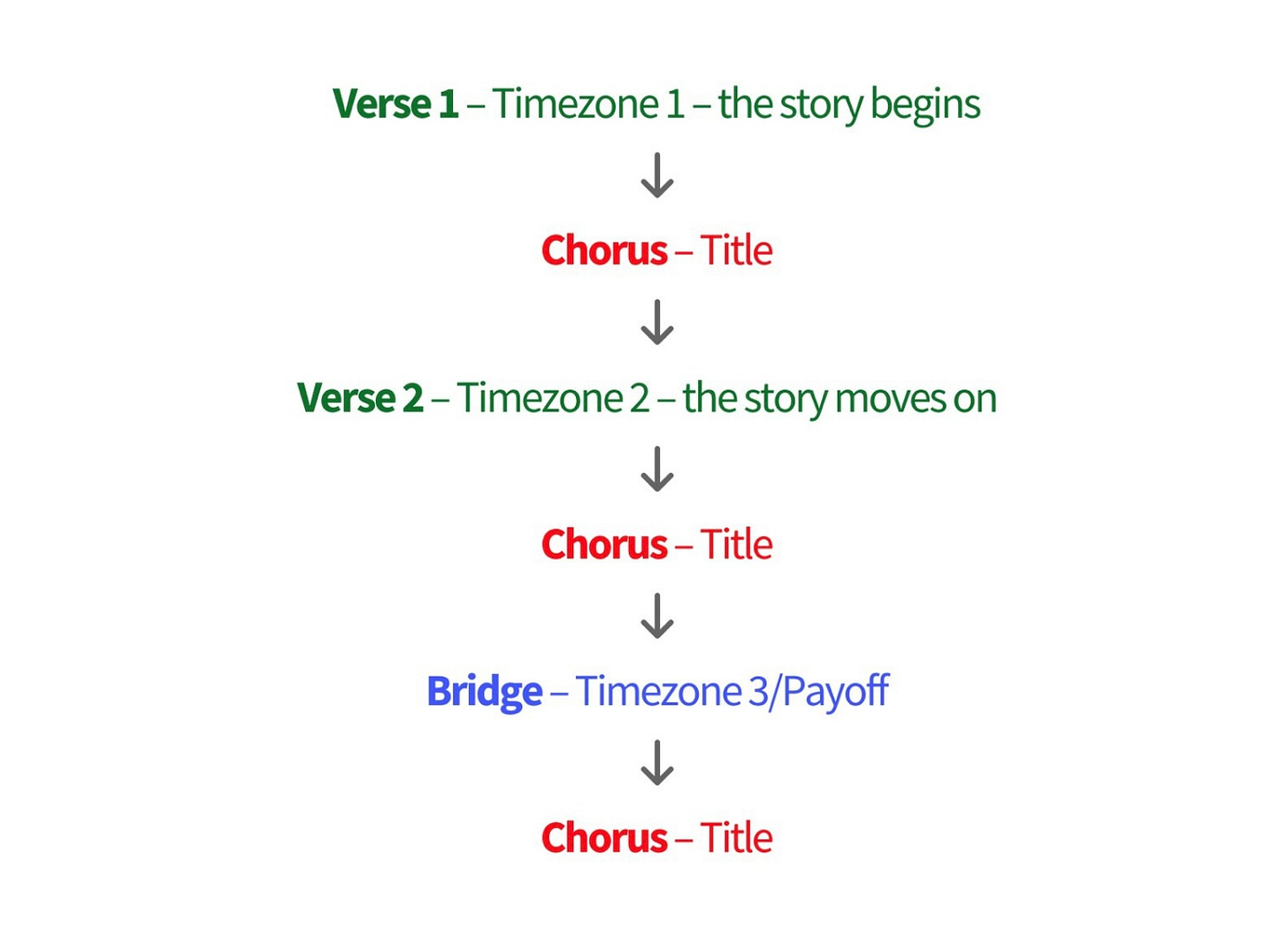Ready to unlock the full potential of your songwriting using TWO TOOLS? Drawing from my book Song Maps - A New System to Write Your Best Lyrics, with seven universal song maps to get started, integrating with a second tool will take your writing to another level. Discover the game-changing technique of pyramiding, a powerful method to elevate your lyrics and bring your music to new heights!
Pyramiding is all about crafting an immersive and captivating experience for listeners. In my friend Andrea Stolpe’s1 brilliant book Popular Lyric Writing: 10 Steps to Effective Storytelling, she delves deeper into this transformative approach.
Picture a pyramid, where the base represents your song's foundation—a single idea or emotion. As your lyrics progress, the pyramid expands, amplifying energy and intricacy. The result? A mesmerizing journey through sound and story that will keep your audience hooked from start to finish.
Let me explain this a little more:
What is Pyramiding?
Creating Contrast with Pyramiding
Pyramiding and Plot Progressions
Integrating Pyramiding with Song Maps
Read on!
What is Pyramiding?
Andrea uses the visual of a Christmas tree, often symbolically drawn as three stacked pyramids. Imagining each tier as a song section, the top tier as a verse, the middle as a pre-chorus, and the bottom as a chorus, you can see how the song's scope broadens as each section progresses. The last line of each section is broader than the first line, and the title, sometimes at the very bottom of the tree, is the widest.
Pyramiding happens on two levels, large-scale and small-scale:
Large-scale pyramiding refers to the overall song structure and how information unfolds as the song progresses through the verses, pre-choruses, and choruses. This approach creates a sense of momentum and direction, making the song move forward. It keeps the listener engaged as the story unfolds, providing a sense of anticipation and satisfaction when the song reaches its climax or hook.
Small-scale pyramiding happens within individual sections like verses,
pre-choruses, and bridges, starting with a simple statement and adding
more detail and emotional depth as the section continues. This creates a
sense of progression even within a single section, making it feel dynamic and interesting.
Pyramiding is a useful tool for songwriters because it creates a natural flow of information and energy, making the song easy to follow and enjoy. It keeps listeners engaged by strategically building and releasing tension. And this is exactly what I also talk about in my book, Song Maps.
This structure also enhances the emotional impact of a song by delivering the most impactful lines or moments precisely when the listener is primed for them.
Creating Contrast with Pyramiding
Pyramiding can create contrast between different sections, ensuring each part of the song has a distinct purpose and stands out. You might have a verse that is narrow and focused while the chorus expands on the idea with more instrumentation and energy.
By strategically contrasting sections, you can create a more dynamic and exciting listening experience. The shifts in energy and focus keep the listener engaged and help to highlight the emotional core of the song.
Pyramiding and Plot Progression
A plot progression, i.e. a Song Map, is the roadmap of your song’s story or map – it dictates how the events unfold and the emotional journey your listener takes. Pyramiding can help craft compelling plot progressions, ensuring your song has a clear beginning, middle, and end.
You can use pyramiding to reveal information, gradually creating intrigue and suspense and leading the listener towards the song's climax or resolution just at the right moment.
So, pyramiding does three essential things in our songwriting:
Creating a natural flow in the song
Building tension and release (see the first universal song map Tension/Release in my book for more), and
Enhance the emotional impact when primed.
So, if you’re writing the songwriting system I introduced in my Song Maps book, integrating this with Andrea’s Pyramiding technique, you have a superpower way of writing your songs. Let me say more about what I mean…
Integrating Pyramiding with Song Maps
Pyramiding and song maps work together beautifully to create powerful and engaging songs.
A Powerful Combination for Crafting Engaging Songs
Here's how to use it:
Song Maps as Blueprints: Song Maps, like those described in my book, act as blueprints for a song's lyrical journey. They provide a framework for the overall structure and plot progression.
Pyramiding Enhances the Framework: Within that framework, pyramiding can be used to shape the information flow and energy within each section. This ensures that even within the structured path laid out by a song map, there is a sense of momentum and progression.
Example: Timezones Map and Pyramiding: Imagine using the "Timezones" Song Map from my book:
This map guides the songwriter in telling a story that unfolds across different time zones. Pyramiding can enhance this structure:
Verse 1 (Timezone 1): Start with a narrow focus on a specific detail or emotion from that period. As the verse progresses, gradually expand the scope, adding more details and emotional depth.
Chorus: The chorus, representing the overarching theme or message, becomes the broadest point in the pyramid for this section of the song.
Verse 2 (Timezone 2): Employ the same pyramiding technique, starting narrow and gradually widening the scope of information and intensity.
Bridge: This section often provides a moment of reflection, a shift in perspective, or even develops the payoff from the plot. Pyramiding can be used here to start with a narrow focus and then broaden the idea, leading to a powerful return to the chorus.
Here are two other things –
Pyramiding Adds Nuance: By using pyramiding within each section of a song map, you can avoid a static or repetitive feel. The information and energy continuously evolve, making the song dynamic and captivating.
Combined Effect: Combining song maps and pyramiding creates a synergistic effect. The map provides the overall structure and direction, ensuring a coherent narrative, while pyramiding ensures each section within that structure is compelling and engaging.
In essence, song maps and pyramiding are complementary techniques. Song maps provide the scaffolding, and pyramiding fills the details with dynamic and purposeful information flow.
Conclusion
Pyramiding is a technique every songwriter can use to elevate their craft. When you combine it with any of the seven universal Song Maps as well, you have a superpower. It’s more than just a structural tool; it's a way to control the listener's experience, guide their emotions, and ensure your song leaves a lasting impact.
To learn more about pyramiding and Andrea Stolpe’s insights into commercial songwriting, check out her book Popular Lyric Writing: 10 Steps to Effective Storytelling. It’s great!
If you want to know more about another technique for songwriting lyrics - Song Painting - click here.
Questions
Here are a few questions to think about:
How can you use pyramiding to enhance the emotional arc of your next song?
What are some ways to avoid making your songs feel formulaic when using pyramiding?
Which of your favorite songs effectively use pyramiding, and what can you learn from them?
Hope this helps!
Simon
Andrea Stolpe is a multiplatinum songwriter, performing artist, and educator. She has worked as a staff writer for EMI, Almo-Irving, and Universal Music Publishing. Her songs have been recorded by artists including Faith Hill, Jimmy Wayne, Julianne Hough, and others. Andrea is the author and instructor of the course Commercial Songwriting Techniques, part of Berklee Online's songwriting program.




